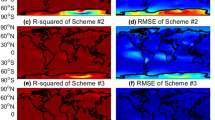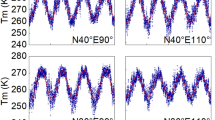Abstract
The weighted mean temperature (Tm) is a function of atmospheric temperature and vertical humidity profiles. It plays a crucial role in the progress of retrieving water vapor information from the tropospheric delay of GNSS signals. The Tm estimated by the empirical models is always used to convert the zenith wet delay (ZWD) to precipitable water vapor (PWV) in GNSS meteorology. However, these empirical Tm models used trigonometric functions, making it difficult to describe Tm in detail and leading to an obvious accuracy difference with latitude changes. Thus, a global latitude zone augmentation mode was adopted for the empirical Tm models; the augmentation coefficients for each latitude zone were obtained by introducing the measured surface temperature and using the least-squares method. Using the Tm data of 2011–2015 derived from radiosonde, the GPT3 model, UNB3m model, and GWTMD model were augmented and analyzed. The results show that all augmentation models can improve the accuracy of the estimated Tm compared with their corresponding original models, and their levels of improvement are different. The three augmentation models achieved an average RMSE of 2.79 K, 3.47 K, and 3.22 K, which correspond to 22%, 49%, and 8% improvement against the GPT3 model, UNB3m model, and GWTMD model. In addition, the comparisons with the Tm linear formula were carried out and showed the superiority of the augmentation models.








Similar content being viewed by others
Data availability
The datasets generated and analyzed during the current study are available from the corresponding author upon reasonable request. The radiosonde data can be found at http://weather.uwyo.edu/ypperair/sounding.html.
References
Bevis M, Businger S, Herring TA, Rocken C, Anthes R, Ware R (1992) GPS meteorology: remote sensing of atmospheric water vapor using the global positioning system. J Geophys Res Atmos 97(D14):15787–15801
Bevis M, Businger S, Chiswell S, Herring T, Anthes R, Rocken C, Ware R (1994) GPS meteorology: mapping zenith wet delays onto precipitable. J Appl Meteorol 33:379–386
Böhm J, Möller G, Schindelegger M, Pain G, Weber R (2015) Development of an improved empirical model for slant delays in the troposphere (GPT2w). GPS Solut 19(3):433–441
Chen P, Yao W (2015) GTm_X: A new version global weighted mean temperature model. Paper presented at China satellite navigation conference (CSNC) 2015 Proceedings, lecture notes in electrical engineering 341, Xian, China.
Chung E, Soden B, Sohn B, Shi L (2014) Upper-tropospheric moistening in response to anthropogenic warming. Proc Natl Acad Sci USA 111(32):11636–11641. https://doi.org/10.1073/pnas.1409659111
Davis J, Herring T, Shapiro I, Rogers A, Elgered G (1985) Geodesy by radio interferometry: effects of atmospheric modeling errors on estimates of baseline length. Radio Sci 20:1593–1607
Dousa J, Elias M, Vaclavovic P, Eben K, Pavel K (2018) A two-stage tropospheric correction model combining data from GNSS and numerical weather model. GPS Solut 22(3):77
Duan JP, Bevis M, Fang P, Bock Y, Chiswll S, Businger S, Rocken C, Solheim F, Hove T, Ware R (1996) GPS meteorology: direct estimation of the absolute value of precipitable water. J Appl Meteorol 35:830–838
He C, Wu S, Wang X, Hu A, Wang Q, Zhang K (2017) A new voxel-based model for the determination of atmospheric weighted mean temperature in GPS atmospheric sounding. Atmos Meas Tech 10(6):3651–3660
He C, Yao Y, Zhao D, Li K, Qian C (2013) GWMT global atmospheric weighted mean temperature models: development and refinement. Paper presented at China satellite navigation conference (CSNC) 2013 Proceedings, lecture notes in electrical engineering 244, Wuhan, China.
Huang L, Jiang W, Liu L, Chen H, Ye S (2018) A new global grid model for the determination of atmospheric weighted mean temperature in GPS precipitable water vapor. J Geodesy 93:159–176
Huang L, Liu L, Chen H, Jiang W (2019) An improved atmospheric weighted mean temperature model and its impact on GNSS precipitable water vapor estimates for China. GPS Solut 23(2):51
Huang L, Mo Z, Xie S, Liu L, Kang C, Wang S (2021) Spatiotemporal characteristics of GNSS-derived precipitable water vapor during heavy rainfall events in Guilin. China Satell Navig 2:13. https://doi.org/10.1186/s43020-021-00046-y
Landskron D, Bohm J (2018) VMF3/GPT3: refined discrete and empirical troposphere mapping functions. J Geodesy 92:349–360
Leandro R, Langley R, Santos M (2008) UNB3m_pack: a neutral atmosphere delay package for radiometric space techniques. GPS Solut 12:65–70
Long F, Hu W, Dong Y, Wang J (2021) Neural network-based models for estimating weighted mean temperature in China and adjacent areas. Atmos 12(2):169
Sun Z, Zhang B, Yao Y (2019) A global model for estimating tropospheric delay and weighted mean temperature developed with atmospheric reanalysis data from 1979 to 2017. Remote Sens 11(16):1893
Wang X, Zhang K, Wu S, Fan S, Cheng Y (2016) Water vapor-weighted mean temperature and its impact on the determination of precipitable water vapor and its linear trend. J Geophys Res Atmos 121(2):833–852
Yang F, Guo J, Meng X, Shi J, Zhang D, Zhao Y (2020) An improved weighted mean temperature (Tm) model based on GPT2w model with Tm lapse rate. GPS Solut 24:46
Yang F, Guo J, Zhang C, Li Y, Li J (2021a) A regional zenith tropospheric delay (ZTD) model based on GPT3 and ANN. Remote Sens 13(5):838
Yang F, Guo J, Meng X, Li J, Zhou L (2021b) A global grid model for calibration of zenith hydrostatic delay. Adv Space Res D14:3574–3583
Yang F, Meng X, Guo J, Yuan D, Chen M (2021c) Development and evaluation of the refined zenith tropospheric delay (ZTD) models. Satell Navig 2:21
Yao Y, Zhu S, Yue S (2012) A globally applicable, season-specific model for estimating the weighted mean temperature of the atmosphere. J Geodesy 86(12):1125–1135
Yao Y, Zhang B, Yue S, Xu C, Peng W (2013) Global empirical model for mapping zenith wet delays onto precipitable water. J Geodesy 87:439–448
Yao Y, Xu C, Zhang B, Cao N (2014a) GTm-III: a new global empirical model for mapping zenith wet delays onto precipitable water vapour. Geophy J Int 197:202–212
Yao Y, Zhang B, Xu C, Chen J (2014b) Analysis of the global Tm-Ts correlation and establishment of the latitude-related linear model. Chin Sci Bull 59(19):2340–2347
Zhang H, Yuan Y, Li W, Ou J, Li Y, Zhang B (2017) GPS PPP-derived precipitable water vapor retrieval based on Tm/Ps from multiple sources of meteorological data sets in China. J Geophys Res Atmos 122:4165–4183. https://doi.org/10.1002/2016JD026000
Acknowledgements
Thanks to the University of Wyoming for providing radiosonde data. This study is supported by Beijing Natural Science Foundation (No. 8224093), China Postdoctoral Science Foundation (No. 2021M703510), the Fundamental Research Funds for the Central Universities (No. 2021XJDC01), Beijing Key Laboratory of Urban Spatial Information Engineering (No. 20220117), State Key Laboratory of Geodesy and Earth’s Dynamics, Institute of Geodesy and Geophysics CAS (SKLGED2022-3-1), the Key Laboratory of South China Sea Meteorological Disaster Prevention and Mitigation of Hainan Province (No. SCSF202109), and the National Natural Science Foundation of China (Nos. 42074036, 42001368). We thank all anonymous reviewers for their valuable, constructive, and prompt comments.
Author information
Authors and Affiliations
Corresponding author
Additional information
Publisher's Note
Springer Nature remains neutral with regard to jurisdictional claims in published maps and institutional affiliations.
Rights and permissions
Springer Nature or its licensor holds exclusive rights to this article under a publishing agreement with the author(s) or other rightsholder(s); author self-archiving of the accepted manuscript version of this article is solely governed by the terms of such publishing agreement and applicable law.
About this article
Cite this article
Yang, F., Wang, L., Li, Z. et al. A weighted mean temperature (Tm) augmentation method based on global latitude zone. GPS Solut 26, 141 (2022). https://doi.org/10.1007/s10291-022-01335-y
Received:
Accepted:
Published:
DOI: https://doi.org/10.1007/s10291-022-01335-y




